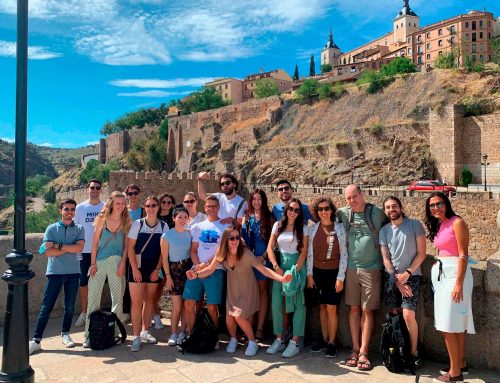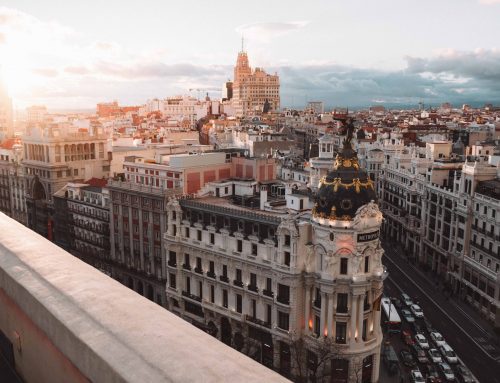Is this your first time in Madrid and you don’t know how to get around the city centre using the public transport? In this post you will get to know the best way to get to any place you want to in the city saving time and money.
Types of public transport in Madrid
Bus
In Madrid you can get to almost anywhere by bus. Its timetable is from 6:00 a.m. to 11:30 p.m. (time when the last bus leaves from the start and the end of the line in each direction). There are city buses and intercity buses, depending on whether you need them to travel around the city (blue buses) or if you want them to travel to a place which lies on the outskirts of Madrid (green buses).
It’s very easy to use a bus in Madrid, just raise your hand to stop it. Once inside, you can use a valid transport ticket placing it near the machine beside the driver, or pay with pocket money (you are not allowed to pay with a note of more than 5€) or your bank card (as you would do with your transport card). There are seats reserved for the elderly and pregnant women where you cannot sit, unless you want to be scolded by the locals! Those seats can be distinguished because they are marked with a white sticker and have a different colour from the rest (green instead of blue).
Free buses in Madrid
There are two buses in Madrid that you can take for free to move around the city centre: 001 bus and 002 bus. They have various stops in the main streets, such as Atocha, Paseo del Prado or Gran Vía Street, and you can get on them without paying for the journey, which is very useful in summer to avoid the heat and walking along the busiest streets in hurry hours! You can find 001 bus at Atocha Station, where many buses stop.
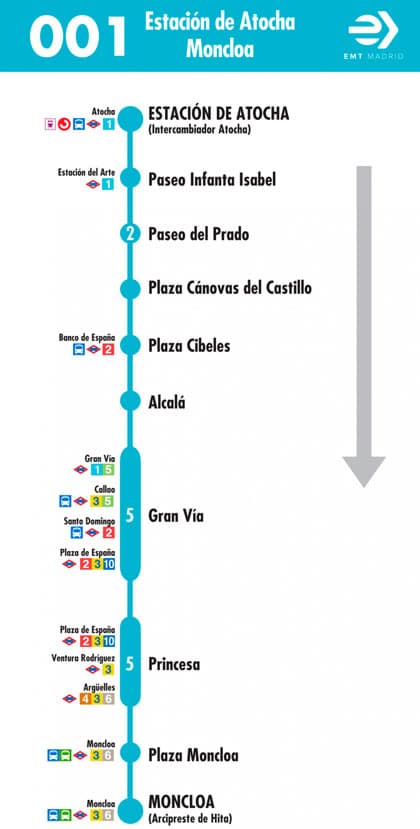
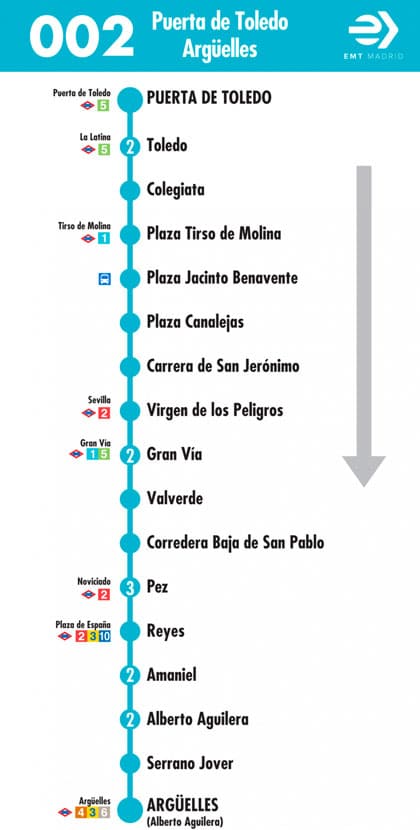
Sightseeing Bus Tour
If you want to see the city’s main monuments quickly and comfortably, you can buy a ticket for the Sightseeing Bus. It is an open-top double-decker bus with audio guide available in all languages. You can take a one or two-day tour of the city, visiting the most remarkable landmarks in Madrid, such as the Royal Palace, the Prado Museum, the Cibeles Fountain or the Real Madrid football team’s stadium, Santiago Bernabéu. The tour duration is 80 or 65 minutes depending on the route. It works from 9 a.m. to 10 p.m. from March to October, and from 10 a.m. to 6 p.m. from November to February. It costs approximately 23€.
Metro
The subway is probably the fastest way to get anywhere in the city of Madrid and tickets cost the same as bus tickets (€1.50 per journey). As you can see below on a piece of Madrid’s metro map, there are different lines, marked in different colours. Each white circle shows the place where several lines connect and you can change lines to go in another direction. At some stations, as well as several lines coinciding, metro lines also coincides with a bus station and both are connected, this is called ‘intercambiador’ in Spain. You might already know the Intercambiador de Atocha, where you can take a bus, metro or train all in the same place. ;)
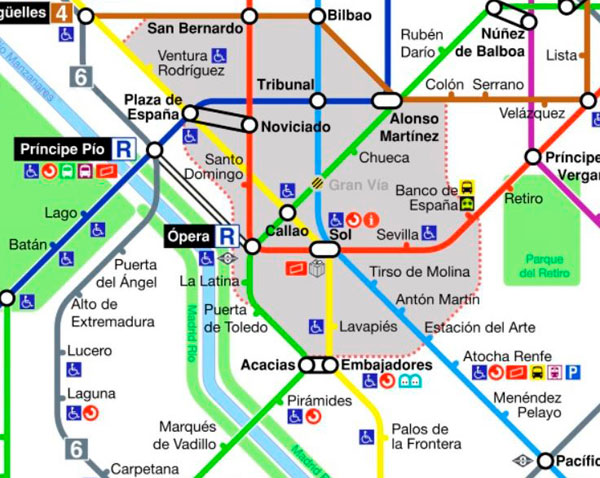
You pay for the metro journey before you enter, at the machines in the station, and you don’t have to do it again when you leave, as it happens in other European cities. Metro is open from 1:30 a.m. to 6 a.m., not working between those hours (the last one leaves at 1:30 a.m., as happened with the buses).
Cercanías
Cercanías are those trains that connect the areas closest to the capital with the city center (hence its name, ‘cercanías’). Renfe or cercanías trains work in exactly the same way as metro, except for the fact that, as it covers more distance, it is more expensive and you have to pass the ticket through the machine at the station both when you enter and when you leave. Cercanías trains work from 5:30 a.m. until midnight and there is another map, different from metro’s, for Cercanías, the one that we show you below or you can find here:
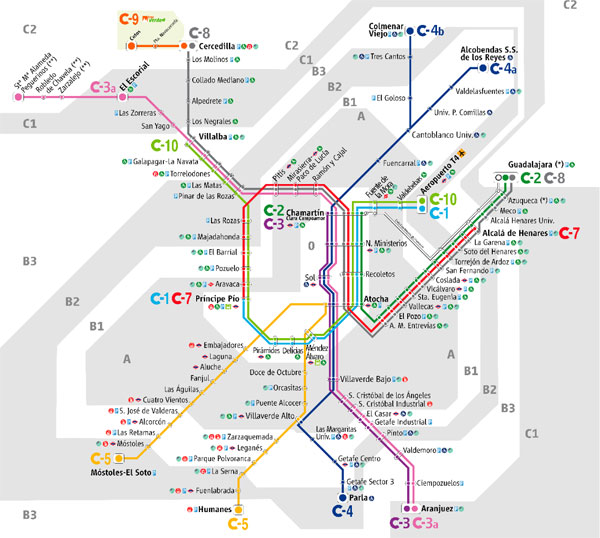
Electric bikes and electric scooters
Finally, in Madrid you can also travel by individual transport, bike or scooter. Both are electric and will be very helpful when you have to bike up through the slopes in Madrid. There are two types of bicycles available for hiring: private companies’ bicycles and public bicycles. Public bikes can be rented at BiciMad docking stations, indicated
In both cases, scooters and bikes, you have to register on a mobile app. For using public bikes in Madrid you have two options: buying an annual pass or paying for the use you make of them in one, three or five days. In the latter case, you will have to do a deposit of 150€ on your bank account, and you will get the deposit back and will be billed at the end of the selected period depending on the use of the service. In the app you can select the place where you want to pick it up and so it gets reserved. You will find bikes with a blue light, green or without any; the ones with no light are not working, the green ones indicate that you can take them and the blue ones indicate that the bike is already reserved.
To return it, the light will turn red and you will have to anchor the bike in the station manually closing the lock on the rear wheel. The light will change to green and a beep will sound so you will know that the bike is already returned.
Electric scooters can be booked on the app of the corresponding private companies: Uber, Bolt, Lime or Wind. All you have to do is to follow the steps provided by each company, register and reserve the scooter with a credit card or PayPal account, and enjoy it! Reminder: In Madrid it is compulsory to wear a helmet when using an electric scooter or bicycle! You will have to ride it on the road, where buses and cars go as well. Keep this in mind if you don’t want to get a fine. 😉
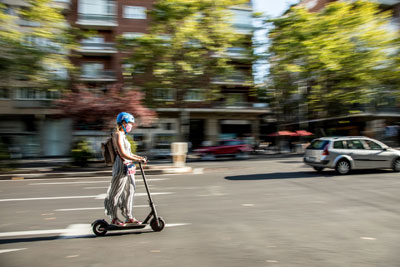
Types of public transport pass in Madrid and which you should buy
Metro and bus tickets
The price of a single ticket in Madrid for travelling by metro or bus is 1,50€. It can be bought at metro stations, at any ‘estanco’ (the place where they sell tobacco) or on the bus itself, to the driver. This price includes a journey from one to five stations. If the place you want to travel to is further than five stations, you will have to pay 10 cents more for each extra station. In the case you want to travel to the airport (we explain you the cheapest ways to get there in this post), you will have to pay a supplement (3€ more).
On the other hand, there are 10-journey tickets, which cost 12,20€ and are not distance-related, it doesn’t matter if the place you are travelling to is closer or further away, as long as you don’t leave Zone A (the one closest to the centre, not the surrounding areas), and no matter if you are travelling by metro or by bus.
There is also a tourist ticket, which is personal, non transferable and allows you unlimited journeys by metro, bus or cercanías trains within the chosen area. This card costs 8,40€ for one day (we have included in this post the fares per number of days). It can be bought at the airport or at any metro station. Kind metro staff will help you out to purchase them.
Tourist ticket fares depending on the number of days:
| Zone | 1 day | 2 days | 3 days | 4 days | 5 days | 7 days |
|---|---|---|---|---|---|---|
| A | 8,40€ | 14,20€ | 18,40€ | 22,60€ | 26,80€ | 35,40€ |
| T | 17€ | 28,40 | 35,40€ | 43€ | 50,80€ | 70,80€ |
*The Zone T tourist ticket includes the entire network of Renfe, metro or bus in the Region of Madrid.
It is important to know that children, young people under 26 years old, people with any disability and people over 65 years have a reduced fare. If you are under 26 years old, we highly recommend you to buy a Montly transport card because it includes all zones and it currently costs only 10€.
Renfe Cercanías tickets
To travel by Cercanías you can buy a single ticket, choosing the origin and destination on the machine’s screen (for one or two zones it costs €1.70), or a round ticket, which is cheaper than buying it separately. Note: If you choose a round ticket, the return journey must be made within two hours after the time you bought it. Ticket prices depend on the number of zones you travel through, you can find out more about Renfe zones on this map.
It is also possible to buy a 10-journey bonotren, to be used for one month on all Renfe’s Madrid Cercanías lines, except line C-9 (the one that goes to the Sierra de Guadarrama). This card can be used by more than one passenger at the same time, as long as they all have the same origin-destination.
The Cercanías Monthly travel card can be a good choice if you have to take the train every day and travel through several areas of the Region of Madrid. This ticket allows you to make two journeys a day for a month after the first use.
| Zones | Single ticket | 10-journey Bonotren | Monthly Cercanías Pass |
|---|---|---|---|
| 1-2 zones | 1,70€ | 10€ | 28,90€ |
| 3 zones | 1,85€ | 13,70€ | 36,70€ |
| 4 zones | 2,60€ | 18,55€ | 59,15€ |
| 5 zones | 3,40€ | 24,30€ | 68,70€ |
Special prices for winter 2022 in the Community of Madrid
From September the 1st to December the 31th, public transport cards in the Community of Madrid will have a reduced fare, as shown in the image below. During this period of time, journeys on Cercanías and Renfe are also for free, fulfilling the following requirements:
- Register as a user on the official ‘Renfe Cercanías’ app.
- Leave a deposit of 10€ by credit card on the app or in cash at a Renfe office.
- Make a minimum of 16 journeys during those 4 months. This is an essential requirement as, if you don’t do it, you will not be refunded the deposit and you will be charged for all journeys at the fare prior to the promotion.
And that’s all! Hope this post have helped you to decide which kind of transport card suits you better. If you are going to spend in Madrid many days, maybe you would like to join our Spanish classes in Madrid. Courses for all levels, no matter if you have no idea, just come and we will teach you. You will be able to speak fluently with native speakers in just a few weeks. 🚀





